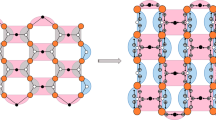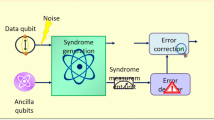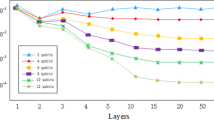Abstract
In order to solve the errors generated during the operation of quantum computers, quantum error correction codes are the most effective candidates at the moment. The best choice of error correction position and the improvement of decoding efficiency are problems that need to be solved urgently. This paper proposes a Grover search algorithm that targets regulatory topological codes, which can be applied to search the most likely error positions of surface code and color code with different code distances. Compared with the previous error qubit search, the error location determination time is shortened by 40\(\%\). According to the error probability of different qubits, the top 30\(\%\) of the qubits are selected for centralized error correction. We use the Generative Adversarial Network (GAN) in machine learning as the error correction training model. The training accuracy of the original neural network can only be improved from about 65\(\%\) to about 98\(\%\). Compared with the 69\(\%\) training accuracy of the minimum perfect matching (MWPM) algorithm, it has been greatly improved. At the same time, in order to speed up the efficiency of decoding and solve the problem of the correlation between surface code and color code vertices and the grid space, we chose a reinforcement learning decoder. Compared with local MWPM decoding, the error correction is only 56\(\%\), and it is difficult to achieve a large error-tolerant calculation under the threshold of about 4\(\%\), which makes the error correction success rate reach 94.5\(\%\) under the GAN training model, and it is better to correct the error. It is possible that the error code can be corrected at a low threshold of about 8.4\(\%\).







Similar content being viewed by others
Explore related subjects
Discover the latest articles, news and stories from top researchers in related subjects.References
Fowler, A.G., Mariantoni, M., Martinis, J.M., Cleland, A.N.: Surface codes: towards practical large-scale quantum computation. Phys. Rev. A. 86, 032324 (2012)
Nickerson, N.H., Li, Y., Benjamin, S.C.: Topological quantum computing with a very noisy network and local error rates approaching one percent. Nat. Commun. 4, 1–5 (2013)
Zhou, N.R., Hua, T.X., Gong, L.H., Pei, D.J., Liao, Q.H.: Quantum image encryption based on generalized Arnold transform and double random-phase encoding. Quantum. Inf. Process. 14, 1193–1213 (2015)
Sarvepalli, P., Raussendorf, R.: Efficient decoding of topological color codes. Phys. Rev. A. 85, 022317 (2012)
Leshno, M., Lin, V.Y., Pinkus, A., Schocken, S.: Multilayer feedforward networks with a nonpolynomial activation function can approximate any function. Neural Netw. 6, 861–867 (1993)
Davaasuren, A., Suzuki, Y., Fujii, K., Koashi, M.: General framework for constructing fast and near-optimal machine-learning-based decoder of the topological stabilizer codes. Phys. Review. R. 2, 033399 (2020)
Fowler, A.G.: Proof of finite surface code threshold for matching. Phys. Rev. Lett. 109, 180502 (2012)
Andersen, C.K., Remm, A., Lazar, S., Krinner, S., Lacroix, N., Norris, G.J., Wallraff, A.: Repeated quantum error detection in a surface code. Nat. Phys. 16, 875–880 (2020)
Yang, L., Liu, Y.C., Li, Y.S.: Quantum teleportation of particles in an environment. Chinese. Phys. B. 29, 060301 (2020)
Deville, A., Deville, Y.: N-qubit system in a pure state: a necessary and sufficient condition for unentanglement. Quantum. Inf. Process. 18, 1–16 (2019)
Peng, T., Harrow, A.W., Ozols, M., Wu, X.: Simulating large quantum circuits on a small quantum computer. Phys. Rev. Lett. 125, 150504 (2020)
Zhou, L., Sheng, Y.B., Long, G.L.: Device-independent quantum secure direct communication against collective attacks. Sci. Bull. 65, 12–20 (2020)
Colomer, L.D., Skotiniotis, M., Muñoz-Tapia, R.: Reinforcement learning for optimal error correction of toric codes. Phys. Lett. A 384, 126353 (2020)
Zhou, N.R., Xu, Q.D., Du, N.S., Gong, L.H.: Semi-quantum private comparison protocol of size relation with d-dimensional Bell states. Quantum. Inf. Process. 20, 1–15 (2021)
Zheng, L.N., Qi, L., Cheng, L.Y., Wang, H.F., Zhang, S.: Defect-induced controllable quantum state transfer via a topologically protected channel in a flux qubit chain. Phy. Rev. A. 102, 012606 (2020)
Shao, C.: A quantum model of feed-forward neural networks with unitary learning algorithms. Quantum. Inf. Process. 19, 1–17 (2020)
Baireuther, P., O’Brien, T.E., Tarasinski, B., Beenakker, C.W.: Machine-learning-assisted correction of correlated qubit errors in a topological code. Quantum. 2, 48 (2018)
Ataides, J.P.B., Tuckett, D.K., Bartlett, S.D., Flammia, S.T., Brown, B.J.: The XZZX surface code. Nat. Commun. 12, 1–12 (2021)
Horsman, C., Fowler, A.G., Devitt, S., Van Meter, R.: Surface code quantum computing by lattice surgery. New. J. Phys. 14, 123011 (2012)
Long, G.L., Li, X., Sun, Y.: Phase matching condition for quantum search with a generalized initial state. Phys. Lett. A. 294, 143–152 (2002)
Mussinger, M., Delgado, A., Alber, G.: Error avoiding quantum codes and dynamical stabilization of Grover’s algorithm. New. J. Phys. 2, 19 (2000)
Schmitt, V., Zhou, X., Juliusson, K., Royer, B., Blais, A., Bertet, P., Esteve, D.: Multiplexed readout of transmon qubits with Josephson bifurcation amplifiers. Phys. Rev. A. 90, 062333 (2014)
Wootton, J.R., Loss, D.: High threshold error correction for the surface code. Phys. Rev. L. 109, 160503 (2012)
Varsamopoulos, S., Criger, B., Bertels, K.: Decoding small surface codes with feedforward neural networks. Quantum. Sci. Technol. 3, 015004 (2017)
Delfosse, N.: Decoding color codes by projection onto surface codes. Phys. Rev. A. 89, 012317 (2014)
Botsinis, P., Babar, Z., Alanis, D., Chandra, D., Nguyen, H., Ng, S.X., Hanzo, L.: Quantum error correction protects quantum search algorithms against decoherence. Sci. Rep. 6, 1–13 (2016)
Qi, L., Yan, Y., Wang, G.L., Zhang, S., Wang, H.F.: Bosonic Kitaev phase in a frequency-modulated optomechanical array. Phys. Rev. A. 100, 062323 (2019)
Varona, S., Martin-Delgado, M.A.: Determination of the semion code threshold using neural decoders. Phys. Rev. A. 102(3), 032411 (2020)
Liu, Y.H., Poulin, D.: Neural belief-propagation decoders for quantum error-correcting codes. Phys. Rev. L. 122, 200501 (2019)
Zhou, N.R., Li, J.F., Yu, Z.B., Gong, L.H., Farouk, A.: New quantum dialogue protocol based on continuous-variable two-mode squeezed vacuum states. Quantum. Inf. Process. 16, 1–16 (2017)
Hu, X.M., Huang, C.X., Sheng, Y.B., Zhou, L., Liu, B.H., Guo, Y., Guo, G.C.: Long-distance entanglement purification for quantum communication. Phys. Rev. L. 126, 010503 (2021)
Premakumar, V.N., Sha, H., Crow, D., Bach, E., Joynt, R.: 2-designs and redundant syndrome extraction for quantum error correction. Quantum. Inf. Process. 20, 1–9 (2021)
Jia, Z.A., Zhang, Y.H., Wu, Y.C., Kong, L., Guo, G.C., Guo, G.P.: Efficient machine-learning representations of a surface code with boundaries, defects, domain walls, and twists. Phys. Rev. A. 99, 012307 (2019)
Huang, Z., Rong, Z., Zou, X., He, Z.: Semi-quantum secure direct communication in the curved spacetime. Quantum. Inf. Process. 20, 1–12 (2021)
Long, G.L.: Grover algorithm with zero theoretical failure rate. Phys. Rev. A. 64, 022307 (2001)
Zhou, N.R., Liu, X.X., Chen, Y.L., Du, N.S.: Quantum K-nearest-neighbor image classification algorithm based on KL transform. Int. J. Theor. Phys. 60, 1209–1224 (2021)
Xu, X., Benjamin, S.C., Yuan, X.: Variational circuit compiler for quantum error correction. Phys. Rev. Appl. 15, 034068 (2021)
Wootton, J.R., Loss, D.: High threshold error correction for the surface code. Phys. Rev. L. 109, 160503 (2012)
Stace, T.M., Barrett, S.D., Doherty, A.C.: Thresholds for topological codes in the presence of loss. Phys. Rev. L. 102, 200501 (2009)
Bai, C.H., Wang, D.Y., Zhang, S., Liu, S., Wang, H.F.: Strong mechanical squeezing in a standard optomechanical system by pump modulation. Phys. Rev. A. 101, 053836 (2020)
Andreasson, P., Johansson, J., Liljestrand, S., Granath, M.: Quantum error correction for the toric code using deep reinforcement learning. Quantum. 3, 183 (2019)
Song, W., Wieśniak, M., Liu, N., Pawłowski, M., Lee, J., Kim, J., Bang, J.: Tangible reduction in learning sample complexity with large classical samples and small quantum system. Quantum. Inf. Process. 20, 1–18 (2021)
Tuckett, D.K., Bartlett, S.D., Flammia, S.T.: Ultrahigh error threshold for surface codes with biased noise. Phys. Rev. L. 120, 050505 (2018)
Laflamme, R., Miquel, C., Paz, J.P., Zurek, W.H.: Perfect quantum error correcting code. Phys. Rev. L. 77(1), 198 (1996)
Liu, Y.H., Poulin, D.: Neural belief-propagation decoders for quantum error-correcting codes. Phys. Rev. L. 122(20), 200501 (2019)
Clader, B.D., Trout, C.J., Barnes, J.P., Schultz, K., Quiroz, G., Titum, P.: Impact of correlations and heavy tails on quantum error correction. Phys. Rev. A. 103, 052428 (2021)
Acknowledgements
We would like to thank Mr. Hongyang Ma for his careful guidance, other authors’ help and the foundations’ strong support including the National Natural Science Foundation of China (Grant Nos. 11975132, 61772295), Natural Science Foundation of Shandong Province, China (No .ZR2019YQ01), Project of Shandong Province Higher Educational Science and Technology Program (No.J18KZ012) and Shandong Provincial Natural Fund Project (No.ZR2021MF049).
Author information
Authors and Affiliations
Corresponding author
Additional information
Publisher's Note
Springer Nature remains neutral with regard to jurisdictional claims in published maps and institutional affiliations.
Rights and permissions
Springer Nature or its licensor holds exclusive rights to this article under a publishing agreement with the author(s) or other rightsholder(s); author self-archiving of the accepted manuscript version of this article is solely governed by the terms of such publishing agreement and applicable law.
About this article
Cite this article
Wang, H., Song, Z., Wang, Y. et al. Target-generating quantum error correction coding scheme based on generative confrontation network. Quantum Inf Process 21, 280 (2022). https://doi.org/10.1007/s11128-022-03616-4
Received:
Accepted:
Published:
DOI: https://doi.org/10.1007/s11128-022-03616-4




